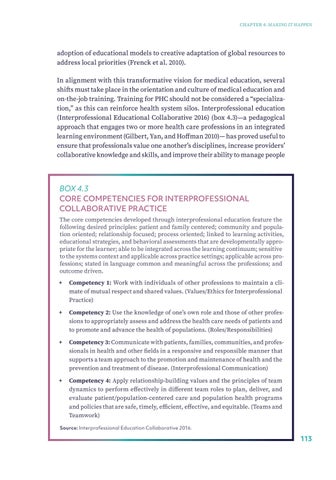CHAPTER 4: MAKING IT HAPPEN
adoption of educational models to creative adaptation of global resources to address local priorities (Frenck et al. 2010). In alignment with this transformative vision for medical education, several shifts must take place in the orientation and culture of medical education and on-the-job training. Training for PHC should not be considered a “specialization,” as this can reinforce health system silos. Interprofessional education (Interprofessional Educational Collaborative 2016) (box 4.3)—a pedagogical approach that engages two or more health care professions in an integrated learning environment (Gilbert, Yan, and Hoffman 2010)— has proved useful to ensure that professionals value one another’s disciplines, increase providers’ collaborative knowledge and skills, and improve their ability to manage people
BOX 4.3 CORE COMPETENCIES FOR INTERPROFESSIONAL COLLABORATIVE PRACTICE The core competencies developed through interprofessional education feature the following desired principles: patient and family centered; community and population oriented; relationship focused; process oriented; linked to learning activities, educational strategies, and behavioral assessments that are developmentally appropriate for the learner; able to be integrated across the learning continuum; sensitive to the systems context and applicable across practice settings; applicable across professions; stated in language common and meaningful across the professions; and outcome driven. ++ Competency 1: Work with individuals of other professions to maintain a climate of mutual respect and shared values. (Values/Ethics for Interprofessional Practice) ++ Competency 2: Use the knowledge of one’s own role and those of other professions to appropriately assess and address the health care needs of patients and to promote and advance the health of populations. (Roles/Responsibilities) ++ Competency 3: Communicate with patients, families, communities, and professionals in health and other fields in a responsive and responsible manner that supports a team approach to the promotion and maintenance of health and the prevention and treatment of disease. (Interprofessional Communication) ++ Competency 4: Apply relationship-building values and the principles of team dynamics to perform effectively in different team roles to plan, deliver, and evaluate patient/population-centered care and population health programs and policies that are safe, timely, efficient, effective, and equitable. (Teams and Teamwork) Source: Interprofessional Education Collaborative 2016.
113


